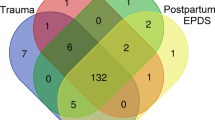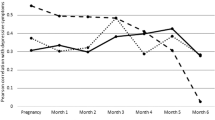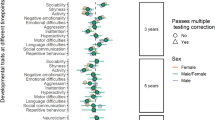Abstract
Effects of DRD4 and 5-HTTLPR length polymorphisms have been reported on neonatal and infant temperament as well as adult personality traits. The 7-repeat form of the DRD4 III exon VNTR polymorphism has been associated with childhood ADHD, and recently we have reported its link with attachment disorganization in a nonclinical population of infants. Here, we report associations of these polymorphisms with infant temperament at 12 months of age. Maternal accounts of temperament and observed response to novelty were investigated for 90 infants, who were independently genotyped for the DRD4 III exon, and for 5-HTT-linked promoter region length polymorphisms. Maternal rating of temperament was not affected by these polymorphisms, but we found combined genotype effects for infants' observed responses to a novel, anxiety-provoking stimulus: the appearance of, and approach by, a stranger. Infants with at least one copy of both the 7-repeat DRD4 allele and the long variant of 5-HTTLPR (7+, l/l&l/s) responded with significantly less anxiety than infants with other genotypes. However, infants with the 7-repeat DRD4 allele and homozygous for the short form of 5-HTTLPR (7+, s/s) showed more anxiety and resistance to the stranger's initiation of interaction. These genotype effects were not redundant with the previously reported association between the 7-repeat DRD4 allele and disorganized attachment behavior. Although both temperament and attachment behavior were affected by the DRD4 repeat polymorphism, the effect on temperament measures was modified by the infants' 5-HTTLPR genotype.
This is a preview of subscription content, access via your institution
Access options
Subscribe to this journal
Receive 12 print issues and online access
$259.00 per year
only $21.58 per issue
Buy this article
- Purchase on Springer Link
- Instant access to full article PDF
Prices may be subject to local taxes which are calculated during checkout

Similar content being viewed by others
References
Ebstein R, Benjamin J, Belmaker RH . Personality and polymorphisms of genes involved in aminergic neurotransmission. Eur J Pharmacol 2000; 410: 205–214.
Van Tol HHM, Wu CM, Guan HC, Ohara K, Bunzow JR, Civelli O et al. Multiple dopamine D4 receptor variants in the human population. Nature 1992; 358: 149–152.
Chang FM, Kidd JR, Livak KJ, Pakstis AJ, Kidd KK . The worldwide distribution of allele frequencies at the human dopamine D4 receptor locus. Hum Genet 1996; 98: 91–101.
Ashgari V, Sanyal S, Buchwalt S, Paterson A, Jovanovic V, Van Tol HHM . Modulation of intracellular cyclic AMP levels by different human dopamine D4 receptor variants. J Neurochem 1995; 65: 1157–1165.
Lesch K-P, Bengel D, Heils A, Sabol SZ, Greenberg B, Petri S et al. Association of anxiety-related traits with a polymorphism in the serotonin transporter gene regulatory region. Science 1996; 274: 1527–1531.
Heils A, Teufel A, Petri S, Stober G, Riederer P, Bengel D et al. Allelic variation of human serotonin transporter gene expression. J Neurochem 1996; 66: 2621–2624.
Greenberg BD, Tolliver TJ, Huang SJ, Li Q, Bengel D, Murphy DL . Genetic variation in the serotonin transporter promoter region affects serotonin uptake in human blood platelets. Am J Med Genet 1999; 88: 83–87.
Ebstein RP, Novick O, Umansky R, Priel B, Osher Y, Blaine D et al. Dopamine D4 receptor (D4DR) exon III polymorphism associated with the human personality trait of Novelty Seeking. Nature Genet 1996; 12: 78–80.
Benjamin J, Li L, Patterson C, Greenberg BD, Murphy DL, Hamer DH . Population and familial association between the D4 dopamine receptor gene and measures of Novelty Seeking. Nat Genet 1996; 12: 81–84.
Ebstein RP, Levine J, Geller V, Auerbach J, Gritsenko I, Belmaker RH . Dopamine D4 receptor and serotonin transporter promoter in the determination of neonatal temperament. Mol Psychiatry 1998; 3: 238–246.
Greenberg BD, Li Q, Lucas FR, Hu S, Sirota LA, Benjamin J et al. Association between the serotonin transporter promoter polymorphism and personality traits in a primarily female population sample. Am J Med Genet (Neuropsychiat Genet) 2000; 96: 202–216.
Osher Y, Hamer D, Benjamin J . Association of anxiety-related traits with a functional polymorphism of the serotonin transporter gene regulatory region in Israeli sibling pairs. Mol Psychiatry 2000; 5: 216–219.
Jorm AF, Prior M, Sanson A, Smart D, Zhang Y, Easteal S . Association of a functional polymorphism of the serotonin transporter gene with anxiety-related temperament and behavior problems in children: a longitudinal study from infancy to the mid-teens. Mol Psychiatry 2000; 5: 542–547.
Auerbach J, Geller V, Lezer S, Shinwell E, Belmaker RH, Levine J et al. Dopamine D4 receptor (D4DR) and serotonin transporter promoter (5-HTTLPR) polymorphisms in the determination of temperament in 2-month-old infants. Mol Psychiatry 1999; 4: 369–373.
Swanson JM, Sunohara GA, Kennedy JL, Regino R, Fineberg E, Wigal T et al. Association of the dopamine receptor D4 (DRD4) gene with a refined phenotype of attention deficit hyperactivity disorder (ADHD): a family-based approach. Mol Psychiatry 1998; 3: 38–41.
Holmes J, Payton A, Barrett JH, Hever T, Fitzpatrick H, Trumper AL et al. A family-based and case-control association study of the dopamine D4 receptor gene and dopamine transporter gene in attention deficit hyperactivity disorder. Mol Psychiatry 2000; 5: 523–530.
Manor I, Eisenberg J, Tyano S, Sever Y, Cohen H, Ebstein R et al. Family-based association study of the serotonin transporter promoter region polymorphism (5-HTTLPR) in attention deficit hyperactivity disorder. Am J Med Genet 2001; 105: 91–95.
Grice DE, Leckman JF, Pauls DL, Kurlan R, Kidd KK, Pakstis AJ et al. Linkage disequilibrium of an allele at the dopamine D4 receptor locus with Tourette's syndrome by TDT. Am J Hum Genet 1996; 59: 644–652.
Comings ED, Gonzalez N, Wu S, Gade R, Muhleman D, Saucier G et al. Studies of the 48 bp repeat polymorphism of the DRD4 gene in impulsive, compulsive, addictive behaviors: Tourette syndrome, ADHD, pathological gambling, and substance abuse. Am J Med Genet 1999; 88: 358–368.
Collier D, Stober G, Li T, Heils A, Catalano M, Di Bella D et al. A novel functional polymorphism within the promoter of the serotonin transporter gene: possible role in susceptibility to affective disorders. Mol Psychiatry 1996; 1: 453–460.
Lakatos K, Toth I, Nemoda Z, Ney K, Sasvari-Szekely M, Gervai J . Dopamine D4 receptor (DRD4) polymorphism is associated with attachment disorganization in infants. Mol Psychiatry 2000; 5: 633–637.
Rothbart MK . Measurement of temperament in infancy. Child Dev 1981; 52: 569–578.
Bates JE . The concept of difficult temperament. Merrill-Palmer Quart 1980; 26: 299–319.
Bates JE, Bayles K . Objective and subjective components in mothers' perception of their children from age 6 months to 3 years. Merrill-Palmer Quart 1984; 30: 111–130.
Sameroff AJ, Seifer R, Elias PK . Sociocultural variability in infant temperament ratings. Child Dev 1982; 53: 164–171.
Vaughn BE, Bradley CF, Joffe LS, Seifer R, Barglow P . Maternal characteristics measured prenatally are predictive of ratings of temperamental ‘difficulty’ on the Carey Infant Temperament Questionnaire. Dev Psychol 1987; 23: 152–161.
Gaensbauer TJ, Mrazek D, Emde RN . Patterning of emotional response in a modified ‘strange situation’ paradigm. Infant Behav Dev 1979; 2: 163–178.
Rothbart MK, Derryberry D . Development of individual differences in temperament. In: Lamb ME, Brown AL (eds). Advances in Developmental Psychology, Vol 1. Lawrence Erlbaum: Hillsdale, NJ, 1981, pp 37–86.
Rothbart MK . Temperament and the development of inhibited approach. Child Dev 1988; 59: 1241–1250.
Ainsworth M, Wittig B . Attachment and exploratory behavior of one-year-olds in a strange situation. In: Foss BM (ed). Determinants of Infant Behavior. Methuen: London, 1969, pp 113–136.
Martin P, Bateson P . Measuring Behaviour, 2nd edn. Cambridge University Press: Cambridge, UK, 1993, pp 114–124.
Ronai Z, Guttman A, Nemoda Z, Staub M, Kalasz H, Sasvari-Szekely M . Rapid and sensitive genotyping of dopamine D4 receptor tandem repeats by automated ultra-thin-layer gel electrophoresis. Electrophoresis 2000; 21: 2058–2061.
Barta C, Ronai Z, Nemoda Z, Szekely A, Kovacs E, Sasvari-Szekely M et al. Analysis of dopamine D4 receptor gene (DRD4) polymorphism using microchip electrophoresis. J Chromatogr A 2001; in press.
Gelernter J, Cubells JF, Kidd JR, Pakstis AJ, Kidd KK . Population studies of polymorphisms of the serotonin transporter protein gene. Am J Med Genet 1999; 88: 61–66.
Wong AHC, Buckle CE, Van Tol HHM . Polymorphisms in dopamine receptors: what do they tell us? Eur J Pharmacol 2000; 410: 183–203.
Siegel S, Castellan Jr NJ . Nonparametric Statistics for the Behavioral Sciences, 2nd edn. McGraw-Hill: New York, 1988, p 130.
Emde RN, Gaensbauer T . Some emerging models of emotion in human infancy. In: Immelmann K, Barlow GW, Petrinovich L, Main M (eds). Behavioral Development. Cambridge University Press: Cambridge, UK, 1981, pp 568–588.
Champoux M, Bennett A, Lesch K-P, Heils A, Nielsen DA, Higley JD et al. Serotonin transporter gene polymorphism and neurobehavioral development in rhesus monkey neonates. Soc Neurosci Abstr 1999; 25: 32.12.
Goldsmith HH, Lemery KS, Buss KA, Campos JJ . Genetic analyses of focal aspects of infant temperament. Dev Psychol 1999; 35: 972–985.
Stevenson-Hinde J . Temperament and attachment: an eclectic approach. In: Bateson P (ed). The Development and Integration of Behaviour: Essays in Honour of Robert Hinde. Cambridge University Press: Cambridge, UK, 1991, pp 315–329.
Vaughn BE, Bost KK . Attachment and temperament. In: Cassidy J, Shaver PR (eds). Handbook of Attachment. The Guilford Press: New York, 1999, pp 198–225.
Van den Boom D . The influence of temperament and mothering on attachment and exploration: an experimental manipulation of sensitive responsiveness among lower-class mothers and irritable infants. Child Dev 1994; 65: 1457–1477.
Seifer R, Schiller M, Sameroff AJ, Resnick S, Riordan K . Attachment, maternal sensitivity, and infant temperament during the first year of life. Dev Psychol 1996; 32: 12–25.
Van den Boom DC . Neonatal irritability and the development of attachment. In: Kohnstamm G, Bates J, Rothbart M (eds). Temperament in Childhood. Wiley: New York, 1989, pp 299–318.
Spangler G, Grossmann K . Biobehavioral organization in securely and insecurely attached infants. Child Dev 1993; 64: 1439–1450.
Hertsgaard L, Gunnar M, Erickson MF, Nachmias M . Adrenocortical responses to the Strange Situation in infants with Disorganized/Disoriented attachment relationships. Child Dev 1995; 66: 1100–1106.
Acknowledgements
The research presented here was supported by Hungarian Science Fund (OTKA) Grants F 030075 (KL), F 022686 (IT), T 032731, and ETT 30/2000 (MS-S). We thank all the participants who made this research possible.
Author information
Authors and Affiliations
Corresponding author
Rights and permissions
About this article
Cite this article
Lakatos, K., Nemoda, Z., Birkas, E. et al. Association of D4 dopamine receptor gene and serotonin transporter promoter polymorphisms with infants' response to novelty. Mol Psychiatry 8, 90–97 (2003). https://doi.org/10.1038/sj.mp.4001212
Accepted:
Published:
Issue Date:
DOI: https://doi.org/10.1038/sj.mp.4001212
Keywords
This article is cited by
-
Prenatal stress and enhanced developmental plasticity
Journal of Neural Transmission (2018)
-
Genetic polymorphism of serotonin transporter 5-HTTLPR: involvement in smoking behaviour
Journal of Genetics (2011)
-
Personality Mediation of Genetic Effects on Attention-Deficit/Hyperactivity Disorder
Journal of Abnormal Child Psychology (2010)
-
Evidence for epistasis between the 5-HTTLPR and the dopamine D4 receptor polymorphisms in externalizing behavior among 15-year-olds
Journal of Neural Transmission (2009)
-
Serotonin transporter gene polymorphism (5-HTTLPR), environmental conditions, and developing negative emotionality and fear in early childhood
Journal of Neural Transmission (2009)



